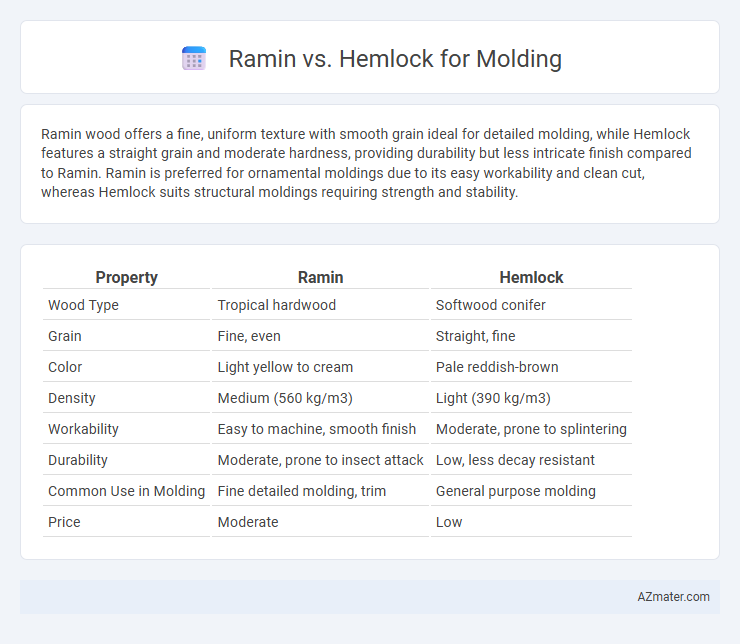Ramin wood offers a fine, uniform texture with smooth grain ideal for detailed molding, while Hemlock features a straight grain and moderate hardness, providing durability but less intricate finish compared to Ramin. Ramin is preferred for ornamental moldings due to its easy workability and clean cut, whereas Hemlock suits structural moldings requiring strength and stability.
Table of Comparison
| Property | Ramin | Hemlock |
|---|---|---|
| Wood Type | Tropical hardwood | Softwood conifer |
| Grain | Fine, even | Straight, fine |
| Color | Light yellow to cream | Pale reddish-brown |
| Density | Medium (560 kg/m3) | Light (390 kg/m3) |
| Workability | Easy to machine, smooth finish | Moderate, prone to splintering |
| Durability | Moderate, prone to insect attack | Low, less decay resistant |
| Common Use in Molding | Fine detailed molding, trim | General purpose molding |
| Price | Moderate | Low |
Introduction to Ramin and Hemlock Wood
Ramin wood, sourced primarily from Southeast Asia, is known for its pale cream to light yellow color and fine, uniform texture, making it ideal for delicate molding and intricate millwork. Hemlock wood, native to North America, features a light reddish-brown hue and a straight grain pattern, commonly valued for its strength and affordability in molding applications. Both woods offer smooth finishes and easy workability, but Ramin's denser fibers provide superior wear resistance compared to Hemlock.
Key Characteristics of Ramin
Ramin wood is highly valued for molding due to its fine, uniform texture and smooth finish, which allows for detailed carving and precise shaping. Its pale yellow to creamy coloration provides a versatile aesthetic that adapts well to various interior designs while maintaining natural warmth. Compared to Hemlock, Ramin offers superior strength and durability, making it ideal for high-traffic areas and intricate trim work.
Key Characteristics of Hemlock
Hemlock wood features a fine, uniform texture with straight grain, making it ideal for detailed molding applications that require smooth finishes and consistent shaping. It offers moderate hardness and good dimensional stability, ensuring that moldings maintain their form without warping or splitting over time. Its pale, light brown color provides a neutral, versatile aesthetic that easily accepts paint or stains, enhancing customization options for interior trims and moldings.
Comparative Durability: Ramin vs Hemlock
Ramin wood offers greater durability than Hemlock for molding applications due to its higher density and natural resistance to decay, making it ideal for both interior and exterior use. Hemlock, while softer and easier to machine, tends to be less resistant to wear, insect damage, and moisture exposure, limiting its longevity in high-traffic or humid environments. Choosing Ramin over Hemlock can result in longer-lasting moldings with superior performance under demanding conditions.
Appearance and Grain Differences
Ramin wood features a pale, creamy color with a fine, straight grain that provides a smooth and uniform appearance, making it ideal for detailed molding work. In contrast, Hemlock displays a light reddish-brown hue with a more pronounced grain pattern, often including knots and resin pockets, resulting in a more rustic and textured finish. The subtle grain of Ramin offers a cleaner, more refined look, while Hemlock's distinct grain adds character and warmth to molded architectural elements.
Workability and Machinability for Molding
Ramin wood offers superior workability for molding due to its fine, uniform texture and straight grain, making it easy to cut and shape without splintering. Hemlock, while also workable, is softer and less dense, which can lead to faster wear on cutting tools but allows for smoother machining at lower speeds. Both woods are suitable for molding, but Ramin's consistent grain and hardness provide better precision and durability in detailed moldings.
Cost Comparison: Ramin vs Hemlock
Ramin wood generally costs more than Hemlock due to its finer grain and higher durability, making it preferred for detailed molding work. Hemlock offers a more budget-friendly option without sacrificing moderate strength and ease of installation in molding applications. Choosing between Ramin and Hemlock depends on balancing the project's budget with the desired finish quality and longevity.
Environmental Sustainability Concerns
Ramin wood, sourced primarily from Southeast Asia, faces significant environmental sustainability concerns due to overharvesting and habitat loss, leading to its classification as a vulnerable species under CITES regulations. Hemlock, predominantly harvested from North American forests, is often considered a more sustainable alternative as it is managed under certified forestry programs like FSC, ensuring responsible logging practices. Choosing hemlock for molding applications supports better environmental outcomes by reducing pressure on endangered tropical hardwoods like ramin.
Best Applications in Molding Projects
Ramin wood is ideal for molding projects requiring fine detailing and smooth finishes due to its uniform texture and pale color, making it perfect for interior trims and cabinetry. Hemlock, known for its strength and dimensional stability, is best suited for structural moldings and exterior applications where durability against warping is essential. Selecting between Ramin and Hemlock depends on the project's aesthetic requirements and environmental exposure, with Ramin favored for precision work and Hemlock for robust, weather-resistant moldings.
Conclusion: Choosing Between Ramin and Hemlock
Ramin offers a smooth, fine texture with excellent workability, making it ideal for detailed molding projects that require a clean finish. Hemlock provides superior strength and stability, suitable for structural molding applications where durability is essential. When selecting between Ramin and Hemlock, prioritize Ramin for intricate designs and Hemlock for robust, long-lasting moldings.

Infographic: Ramin vs Hemlock for Molding
 azmater.com
azmater.com